I don’t know about you readers, but I’m still howlin’ mad about Innistrad: Midnight Hunt. Drafting this set has been maybe my favorite Limited experience since Zendikar Rising and that includes all sorts of different color combinations and archetypes. If you haven’t tried it out yet, we put out a detailed guide last week which can quickly give you some ideas about what good decks look like in this set.
But with another full week of games under our collective belts, the community is starting to reach a stable understanding of the Midnight Hunt Draft metagame. That means that we can start to take those broad impressions from week one, and test them against large datasets from real games and see which ones hold up. We can look for the subtle patterns that give certain cards or colors unexpected influence, and figure out how many payoff cards you actually need to succeed with that sweet niche strategy from Twitter.
For those eager to spend more time with Midnight Hunt Drafts in the coming weeks, and especially those looking to hit Mythic or rake MTGO tickets, it’s essential to stop and look at things by the numbers…
STATS THAT MATTER
One of the most rewarding ways to break down a set statistically is to look at the relative power and toughness of its creatures. How the common and uncommon creatures trade with each other in blocking situations—especially at low mana costs—has a massive impact on the pace of play, and affects the pick priority of every other card.
Let’s start with the data:


I tend to ignore rares and mythics unless otherwise stated; individual rares show up too inconsistently to factor into our pre-draft plans, although it’s nice to be aware of how the good ones change your possibilities.
There’s also an un-scientific aspect to these graphs; many creatures can change their own power and toughness, or they have other abilities which affect combat. For these creatures, I’ve tried to consider which conditions can be reliably activated each time they go into combat, and assign stats based on that. So Snarling Wolf and Festival Crasher count as 3/x’s, but werewolves use their daybound stats and coven buffs are ignored.

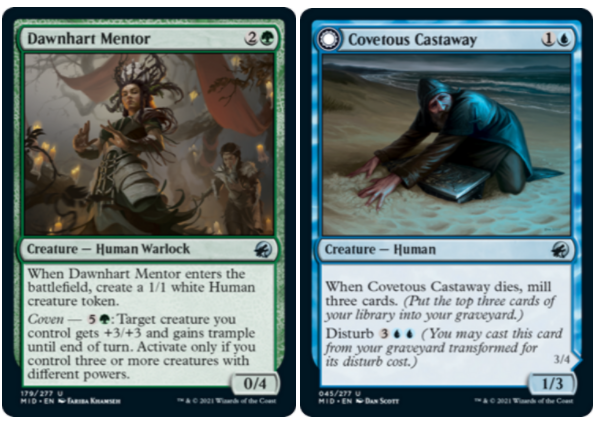
The biggest takeaway is that this is a defensively-slanted set. Out of 29 available two-drops, only four can attack into a three-toughness blocker; two require additional resources to boost their power, and the other two are 3/1s which are just as likely to trade down. Three toughness blockers are made even more important thanks to the omnipresent decayed tokens!
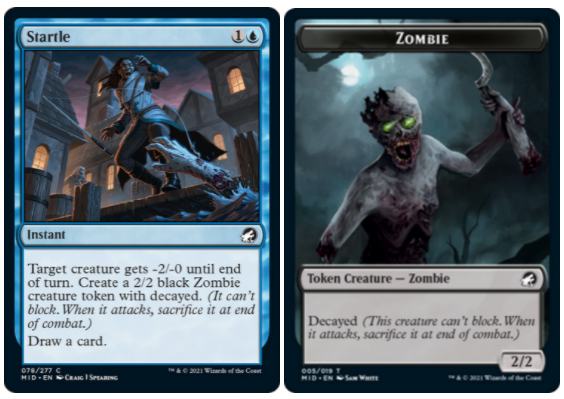
No winning drafter can afford to be trading real cards for 1/3rd of a Startle when UB decks are so popular. This also underlines the massive value of Bladestitched Skaab in those decayed-heavy decks, as it cuts the number of eligible blockers for them in half! The impact of 3+ toughness is readily visible in the winrate stats for commons: Ecstatic Awakener, Diregraf Horde, Eccentric Farmer and even Shipwreck Sifters rank among the top 10, ahead of removal spells, cantrips and most fliers.
INNISTRAD MAKES YOU TOUGH…
In general this set has far more good blockers than bad; there are plenty of x/3s and x/4s for two or three mana, and they’re mostly playable cards in their own right. That said, it’s also a set of lopsided P/Ts in general, with less than a third of statlines having equal power and toughness; a clear sign of formats where attacking is difficult. Most creatures have the potential to trade up, and the defending player has the choice of where that happens.
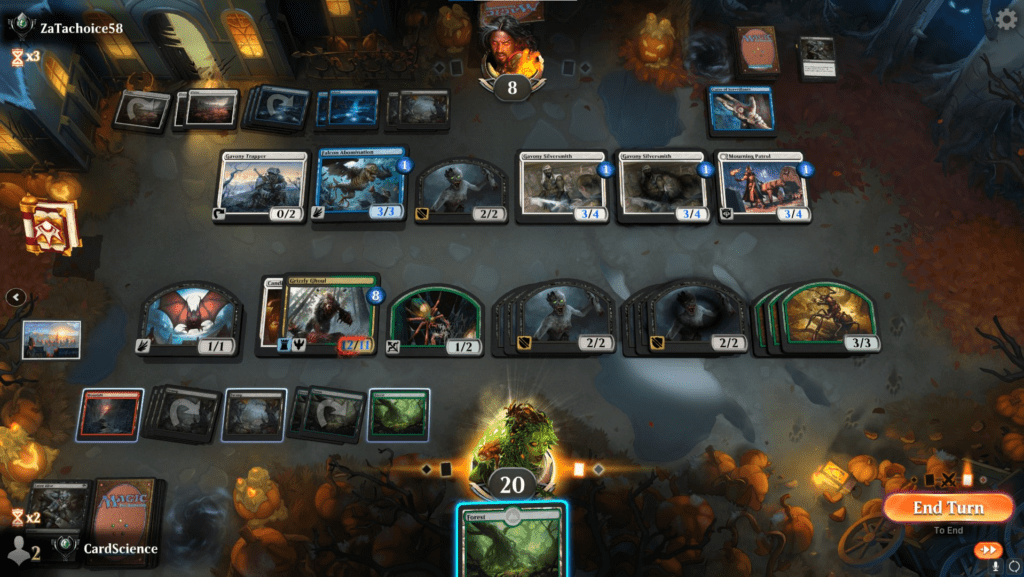
Combine that with lower power creatures in general, and you have a format where walls of blockers make ground attacks pointless, and most games will be slow enough for decks to put that wall together. This is why last week’s draft guide emphasized the importance of a gameplan for winning through a board stall; evasive attackers, engine cards which grow in value over time, or Ol’ Reliable. Really, no card sums up the strategic environment like Ecstatic Awakener: a slow, vulnerable creature which demands investment before producing a sizable threat. It’s the single winning-est common in Midnight Hunt, improving a deck’s chances by a whopping 8% every time it’s drawn.
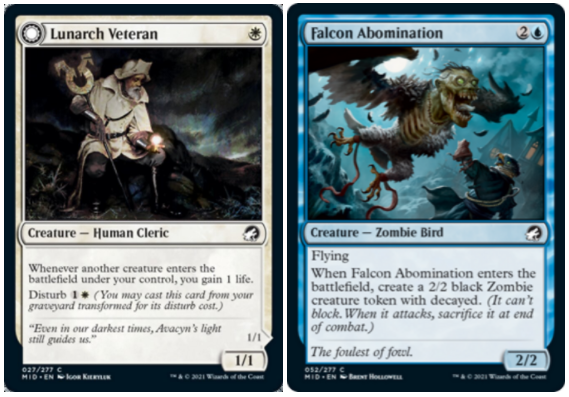
This three-toughness barrier is also a big part of why red lags noticeably behind the other colors in this format, especially red-heavy aggro decks. While red technically has four or five cheap creatures capable of challenging an x/3 blocker, only Harvesttide Infiltrator can do so without spending additional mana to pump up or cast extra spells. This means that trying to attack with more than one creature is difficult. Since you can’t really pay for all of them you’re exposed to being blown out by enemy tricks. Being forced to commit that extra mana just to threaten a trade in the first place is not where we want to be.
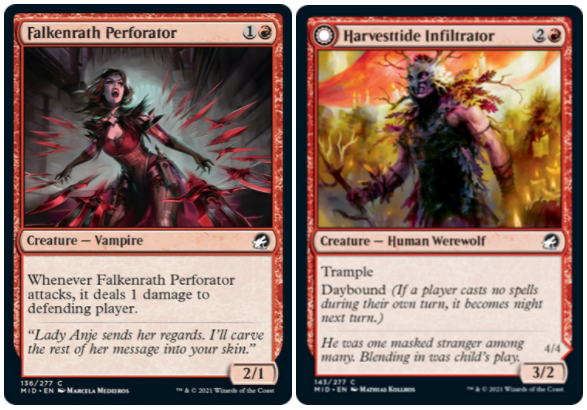

…BUT GREEN MAKES ‘EM TOUGHER
A lot of the talk around Midnight Hunt Limited thus far has focused on how strong the Esper colored decks are, or how rough red has it, but I feel that green’s strengths have been somewhat overlooked. The low overall statlines for the other four colors, especially at higher mana costs, make green’s usual hefty curve of threats a much more tenable advantage in the format. Not only are your fight spells essentially always good, but even in a set light on trample or other evasion you can bully your way to easy wins by just overloading on beasties with four-plus power. Before needing to splash you have Burly Breaker, Candlelit Cavalry, Tireless Hauler, Shadowbeast Sighting, Contortionist Troupe… even the smaller werewolves or Deathbonnet Sprout account for multiple blockers when transformed.
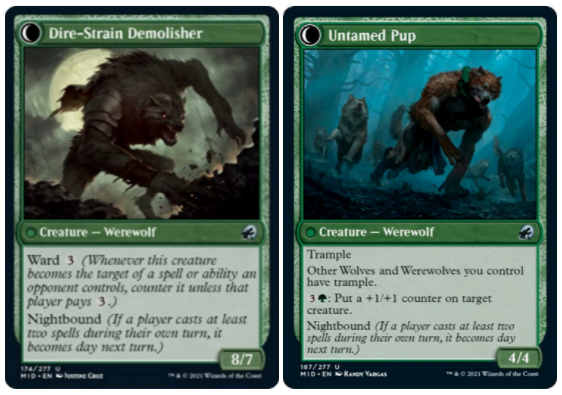

You can rely on this strategy to grind out card advantage—and wins—in part because of how little removal in the set can hit these big bodies. Enemy fight spells obviously rely on outsizing your creatures, while red has to go all the way up to Burn the Accursed at five mana – and even that won’t kill the largest werewolves in nightbound form. Blue’s board control is a little inefficient outside of uncommon Fading Hope, and by leaning into the long game with big stuff, green can make all such temporary answers immaterial.

It’s really just black and white which have the tools to beat back waves of large green attackers. There’s Bladebrand, Hobbling Zombie, Gavony Trapper, Candletrap, Defenestrate, Eaten Alive, and Sungold Barrage at common, and the occasional Borrowed Time, Infernal Grasp, or full-powered Olivia’s Midnight Ambush.
The real secret, though, is to combine black’s best-in-set removal suite with green’s overwhelming stat advantage for easy midrange wins. All of black’s removal shoots up in impact stats when you narrow the sample to GB games specifically: Eaten Alive goes from +3.8% to +5.1%, Defenestrate from +3.6% to +5.9%, Olivia’s Midnight Ambush from +3.8% to +5.1%, and Infernal Grasp from +4.8% to +9.1%.

You can see similar statistical returns from any of green’s large creatures when filtered to GB, as well as stall-focused cards like Dawnhart Mentor and Hound Tamer. All of that in spite of the fact that GB decks have the lowest overall winrate among Bx color combinations on the 17Lands database. What this says to me is that a lot of GB decks aren’t using the strengths of these two colors in the most powerful way: playing conservatively until you massively outsize your opponents with plentiful five-drops, and then ensuring devastating attacks by knocking out the largest blockers with black kill spells. It’s straightforward, but the stats show how fruitful it can be in the specific context of Midnight Hunt.
TWO STEPS FORWARD, ONE FLASH BACK
The consensus is that most of Midnight Hunt’s flashback spells are pretty solid picks – but building the legendary four- or five-color flashback theme in Draft is still a very complex puzzle. Which colors are best as a base? Which of the more specialized payoffs and enablers are worth playing alongside the big flashback spells? And how many flashback cards do you need to reliably go over the top of your opponents?
The multi-layered questions around the deck makes it hard to show all the relevant stat comparisons within the scope of an article like this, but we can hunt through galleries of recent winning lists from Mythic and Diamond players to get some better context on which cards perform together:
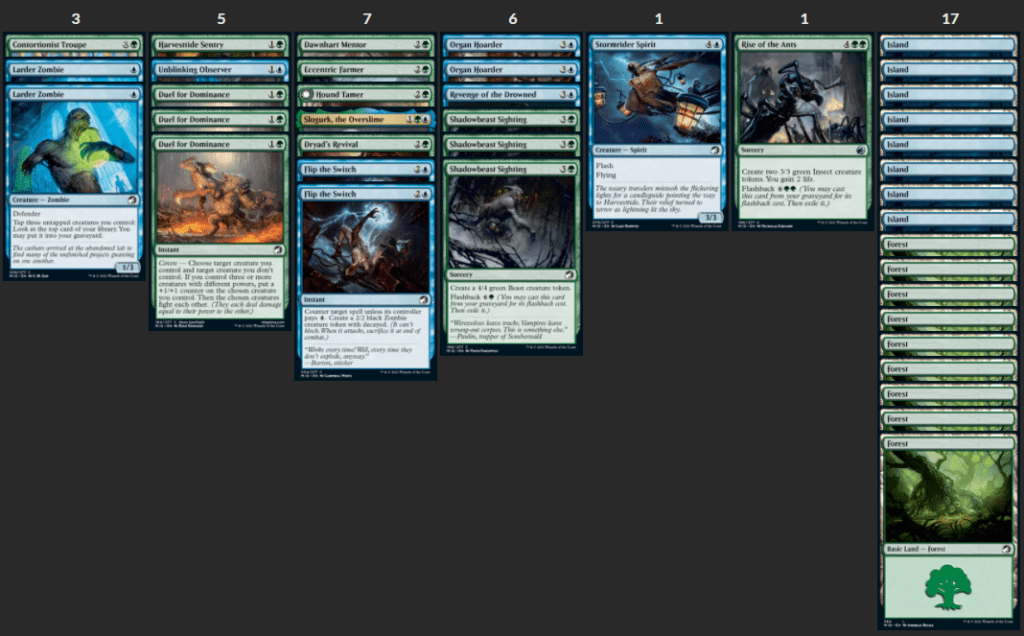


Despite my initial convictions upon trying the set, it does seem like the deck performs best as almost fully UG, with red splashes only about as common as white or black. Seize the Storm does show up, but moreso in strict UR builds which are heavier on counterspells and removal than UGx’s board-based approach.
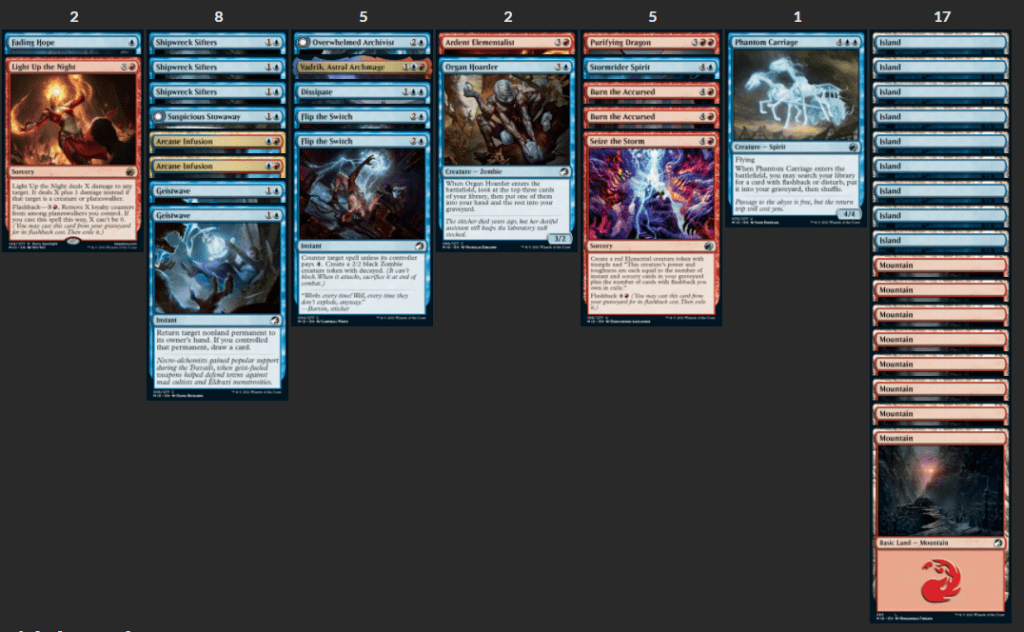
In fact, white seems to be the most optimal third color—the disturb creatures are both early defense and lategame offense, and flashback payoffs like Ominous Roost and Phantom Carriage can offer additional value. Add in white’s decent removal and Faithful Mending, and you have an archetype best suited to the mature Midnight Hunt metagame.
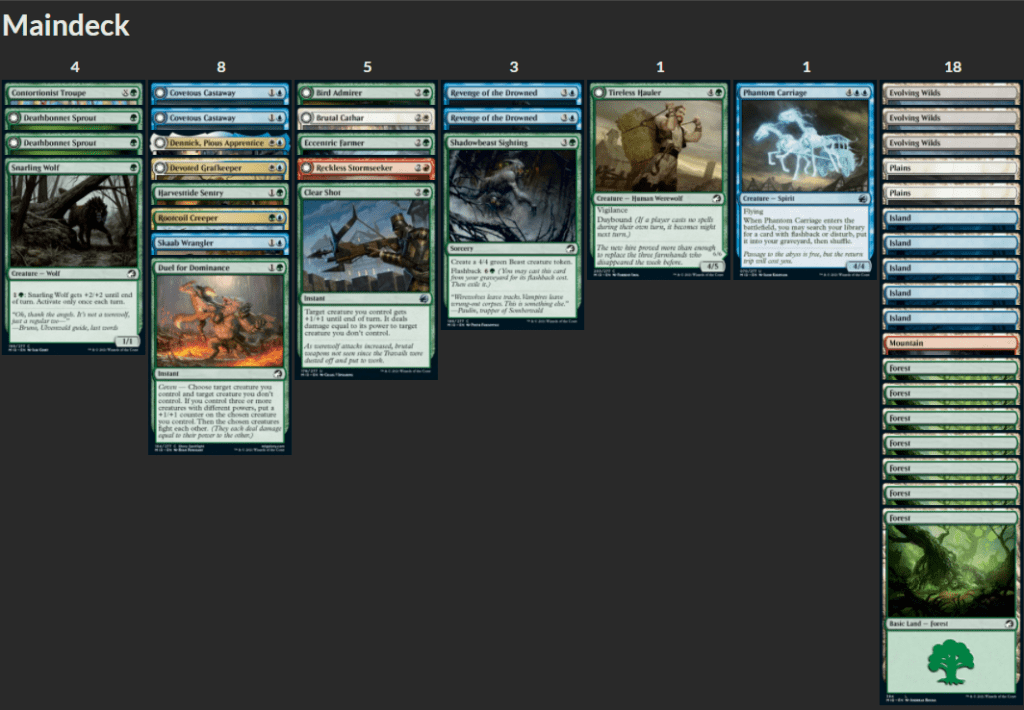
DON’T BE SPOOKED BY STATS!
There’s a lot more you can learn about the finer points of this set, even just by flicking through the card winrate comparisons on 17Lands color by color as we did for GB here. It can sometimes be tricky to make sure you’re taking the right lessons from these numbers, but if you commit to building the habit with each new set—and remember not to trust the numbers blindly—it’s one of the best ways to build up your own instincts, and to get the most out of other draft guides and advice from experts. It’s like the old “teach a friend to fish” proverb, but in this case you can just teach yourself to fish, and what you’ll be catching is draft payouts and Mythic ranks!
While it’s fairly clear that UW and UB have the tools to dictate play in this set, I don’t yet think that other color combinations have yet been figured out to their full potential. With any luck, revisiting some of the stats here in a month or two will be a testament to the relentless curiosity and cunning of the Draft community.

Tom’s fate was sealed in 7th grade when his friend lent him a pile of commons to play Magic. He quickly picked up Boros and Orzhov decks in Ravnica block and has remained a staunch white magician ever since. A fan of all Constructed formats, he enjoys studying the history of the tournament meta. He specializes in midrange decks, especially Death & Taxes and Martyr Proc. One day, he swears he will win an MCQ with Evershrike. Ask him how at @AWanderingBard, or watch him stream Magic at twitch.tv/TheWanderingBard.

